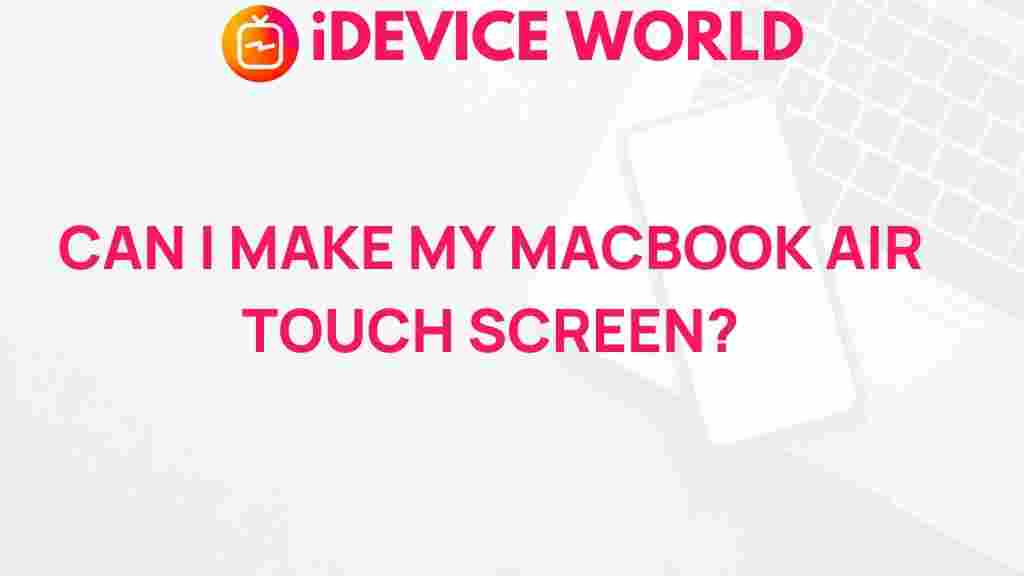Unlocking the Touchscreen Potential of Your MacBook Air
The MacBook Air is known for its sleek design, lightweight portability, and powerful performance. However, many users often wonder if it can rival devices that come with touchscreen capabilities. In this article, we will explore how to unlock the potential of your MacBook Air and enhance your user experience by leveraging touch gestures and other functionalities. Whether you are looking to streamline your workflow or simply make your MacBook Air more interactive, we’ve got you covered.
Understanding the Basics of Your MacBook Air
The MacBook Air runs on macOS, which is designed for a keyboard and trackpad interface. While it doesn’t feature a touchscreen like some of its competitors, you can still enhance your interaction with the device through various settings and applications.
Setting Up Touch Gestures
Your MacBook Air supports a variety of trackpad gestures that can mimic some touchscreen functionalities. Here’s how to set them up:
- Access System Preferences: Click on the Apple icon in the top-left corner and select System Preferences.
- Select Trackpad: In the System Preferences window, click on Trackpad.
- Explore the Options: Here, you can enable different gestures. Some popular gestures include:
- Two-finger scroll: Allows you to scroll through pages and documents with two fingers.
- Pinch to zoom: Zoom in and out of photos and web pages by pinching with two fingers.
- Three-finger swipe: Switch between applications or desktops quickly.
- Practice Gestures: Once you enable them, practice these gestures to become proficient.
Enhancing Your MacBook Air with Third-Party Applications
If you’re looking for a more touchscreen-like experience, consider installing third-party applications that offer enhanced touch features. Here are a few recommendations:
- BetterTouchTool: This powerful app allows you to customize your trackpad gestures extensively. You can create unique gestures for different applications, which can significantly improve your productivity.
- Swipe: The Gesture-Based Application Launcher: This app lets you launch applications using gestures, giving you a seamless experience reminiscent of touchscreens.
- Jitouch: Another excellent tool for customizing gestures, Jitouch allows you to set up additional gestures and shortcuts, making your MacBook Air feel more interactive.
Using Your MacBook Air with an External Touchscreen
If you desire a true touchscreen experience, you might consider using an external touchscreen monitor. Here’s how to set it up:
- Choose the Right Monitor: Look for a touchscreen monitor that is compatible with macOS. Brands like Dell and ASUS offer models that work well.
- Connect the Monitor: Use an HDMI or USB-C cable to connect the monitor to your MacBook Air.
- Configure Display Settings: Go to System Preferences > Displays to adjust the resolution and arrangement of your displays.
- Install Necessary Drivers: Some monitors may require additional drivers to enable full touchscreen functionality. Check the manufacturer’s website for the latest software.
Touchscreen Functionality in Specific Applications
Many applications on your MacBook Air can take advantage of trackpad gestures to enhance user interaction:
- Photo Editing Software: Applications like Adobe Photoshop or Lightroom support gestures for zooming and scrolling, allowing for a more fluid editing experience.
- Web Browsers: Browsers like Chrome and Safari allow for gesture-based navigation. For example, swiping with two fingers can go back or forward in your browsing history.
- Presentation Tools: Tools like Keynote and PowerPoint can utilize gestures for smoother transitions and navigation during presentations.
Troubleshooting Common Issues
While using your MacBook Air with enhanced touch functionalities, you may encounter some issues. Here are some common problems and their solutions:
- Trackpad Not Responding: If your trackpad stops responding to gestures, try restarting your MacBook Air. If the issue persists, check the trackpad settings in System Preferences.
- Gestures Not Working in Specific Applications: Some applications may not support all gestures. Ensure the app is updated to the latest version or check the app’s preferences for gesture settings.
- External Monitor Not Recognized: If your external touchscreen monitor isn’t recognized, check the cable connections and ensure that the monitor is powered on. Try resetting the SMC (System Management Controller) if the problem continues.
Conclusion
While the MacBook Air does not come with a built-in touchscreen, there are many ways to unlock its potential through trackpad gestures, third-party applications, and even external monitors. By utilizing these features, you can enhance your productivity and enjoy a more interactive experience with your device. Embrace the possibilities of your MacBook Air, and make the most out of its capabilities.
For more tips and tricks on maximizing your MacBook Air experience, check out our comprehensive guide on optimizing macOS performance.
If you’re looking for accessories or software that can enhance your MacBook Air, visit Apple’s official website for the latest offerings.
This article is in the category Productivity and created by iDeciveWorld Team
